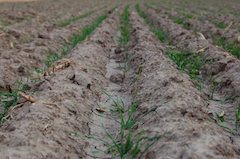January 14, 2015
K-State celebrates 2015 International Year of Soils

Many authors have documented the rise and fall of civilizations throughout time. Reasons for this roller coaster effect are numerous — from human-influenced changes such as conquest, culture or religion, to events that occur in the natural environment including changes in climate or the presence of natural resources, such as soil.
Soil is one of the four essential components for any life to exist, with the other three being water, air and sunlight. Without those four, there simply would not be any food grown on the earth's surface, said Gary Pierzynski, university distinguished professor and head of the agronomy department at Kansas State University.
Civilizations have risen and fallen throughout history due to soil quality and how people manage the soil. So in most cases, the degradation of the soil resource that led to these civilizations' despair was human-influenced. Author Jared Diamond chronicles such stories in his New York Times bestselling book "Collapse."
"It's our job not to turn out like some of these civilizations and have a decline because we don't take care of our soil resource," said Pierzynski, a soil and environmental chemist. "Countries like the United States were founded on a healthy and productive soil resource. When you have that, a large segment of the population can participate in other activities to advance society. The wealth of this country and others like it around the world is related to soil."
As the International Year of Soils takes off in 2015, all people are reminded about the importance of soil in their daily lives. January's theme, "Soils Sustain Life," calls to mind such value.
Conserving soil, enhancing life
Soil provides many benefits for the environment and society, Pierzynski said, including producing food, clothing from cotton, for example, and can be used directly to make bricks and produce lumber for shelter.
"The quality of the soil influences productivity, or the amount of life that does exist," he said. "Productive soils allow us to sustain the population of life that we have, not only humans but all organisms in the environment."
Additionally, soil provides regulating functions, Pierzynski said, as it helps mitigate floods and carbon dioxide in the atmosphere through carbon sequestration. Soil also provides support services related to basic functions in which all life depends, such as nutrient cycling.
Using up plant nutrients in the soil or contributing to the loss of organic matter, which has a negative effect on the soil's physical properties, is called exhaustion, he said. Exhaustion and erosion — the loss of the soil resource altogether through action of wind or water — are the main causes of soil degradation.
"We have learned how to prevent exhaustion by maintaining or replacing some of the critical components in the soil, and we know a lot more about soil erosion, although it still does occur to some extent, even in countries that have good soil conservation practices," Pierzynski said.
One of the most common and visible soil conservation practices includes the use of terraces on sloped fields, which are ridges that help slow the water flow to maintain soil on the field, he said. Another practice is landowners enrolling in the Conservation Reserve Program, or CRP, which takes land out of crop production to allow perennial vegetation to grow and replenish nutrients in the soil, along with preventing erosion. No-till practices leave crop residue on the surface to have similar effects.
When soil quality is diminished, Pierzynski said generally speaking, it could take hundreds if not thousands of years to form an inch of A-horizon material, commonly called topsoil.
That topsoil layer is often the most productive layer, as it has the most organic matter, and can come in hues and shades that range from black to brown, red to orange and yellow to white. Varied soil colors and textures have historically brought life in a cultural way to civilizations as well, Pierzynski said.
"Soil can be used as an art medium and also provides a lot of the recreational activities that we partake in, anything from outdoor activities utilizing various sports fields to the national park system and the enjoyment we get from those," he said.
To watch a video interview with Pierzynski, go to the K-State Research and Extension YouTube page. The Soil Science Society of America has numerous resources for the public, teachers and children about soil and each monthly theme for the International Year of Soils.
